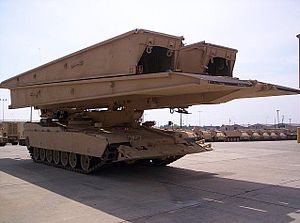M104 Wolverine
| M104 Wolverine | |
|---|---|

M104 Wolverine, 59th Engineer Company, 20th Engineer Battalion, US Army. |
|
| General properties | |
| crew | 2 |
| length | 13.4 m |
| width | 4 m |
| height | 3.95 m |
| Dimensions | 69 t |
| Armor and armament | |
| Armor | Chobham - composite armor |
| Main armament | unarmed |
| Secondary armament | unarmed |
| agility | |
| drive | AGT-1500 gas turbine 1119 kW (1500 hp; 1521 PS) |
| suspension | Torsion bar |
| Top speed | 72 km / h (45 mph) |
| Power / weight | |
| Range | 418 km (260 mi) |
The M104 Wolverine is a bridge-laying tank of the US armed forces and belongs to the group of combat support vehicles. It is based on the hull of the M1 Abrams .
development
With the procurement of the M1 Abrams for the US armed forces, the inadequacy of the bridge-laying M60A1 Armored Vehicle Launched Bridge (AVLB) became apparent . So the load capacity of the bridge was reached and the Abrams could only pass at walking pace. The carrier vehicle, a converted M60 , was also underpowered in order to be able to follow the battle tank in battle. An increase in combat value was not seen as a solution.
In 1983, the armaments industry was commissioned with a new development. A potential project was a Heavy Assault Bridge , the Double Fold Scissors Bridge from Bowen McLaughlin York and Israel Military Industries on a modified M1 tub, but development was halted in 1990 due to changes in the financial budget.
With the beginning of the Second Gulf War and Operation Desert Storm , however, it quickly became apparent that a new bridge-layer was inevitable. So in 1991 the development was pushed forward, but the decision was made to re-tender the bridge. A total of three systems were presented as a solution, of which the German Iguana system from MAN Mobile Bridges GmbH (a subsidiary of Krauss-Maffei Wegmann since 2005 ), represented by General Dynamic Landsysteme, was ultimately selected in 1994 . The project was then named XM104 Wolverine.
Due to changes in the planning, the carrier vehicle was changed to the M1A2 SEP level in 1996. The US Army planned to buy 465 vehicles, but only 44 vehicles were produced between 1997 and 2001; the rest were canceled without replacement after a budget cut.
General
In contrast to the M60A1 AVLB, the Leguan rapid-transit armored bridge is laid horizontally in a free front structure. Compared to the other scissor method, in which the bridge is unfolded vertically and then laid, this variant offers a significantly lower silhouette. The aluminum bridge has a total length of 26 m with a total weight of 10.5 tons and enables terrain cuttings up to 24 m wide to be overcome. It carries loads up to military load class 70 at a maximum of 16 km / h. The laying time is five minutes, the recording eight to ten minutes. The entire laying process corresponds to the Biber rapid-transit tank bridge , but is carried out with computer support.
The M1A2 SEP serves as the carrier vehicle. The bridge-layer has the digital on-board network, the auxiliary unit for power generation and, in a slightly modified form, the command interface for using the FBCB2 network. The entire installation technology was accommodated in the slewing ring and supplemented with a support plate. The crew consists of two soldiers, the driver and the commander (operator). The bridge-layer himself is unarmed. The maximum speed is 72 km / h, 32.2 km / h off-road and 56 km / h on paved roads.
